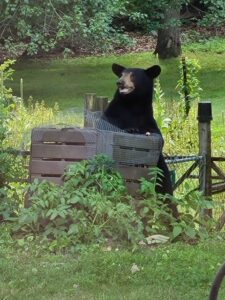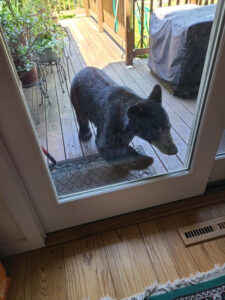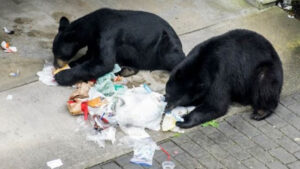
You wanted to live close to nature, and the Hudson Valley was the perfect combination of gorgeous vistas, waterways, nature trails, and wildlife, all within a stone’s throw of the one, the only — New York City.
As the saying goes, “be careful what you wish for.” Unlike Dorothy and her friends, we may not share the land here with lions and tigers, but seen any bears lately?
For some people close is one thing, but – oh my — in your backyard? Crash! Boom! Thud! You look outside to find that you have quite a large new friend literally “trashing” your trash can.
FORAGING FOR FOOD
Obviously, the innocent interloper has simply found an attractive food source. Bears are no different than any other wildlife when it comes to foraging food for survival.
They will go anywhere for it, especially if it’s what you might call low-hanging fruit, within easy reach.
To avoid any possible bear–human contact, let alone conflict, the key is to understand why the bears are wandering into more people-populated areas, and what to do to deter their interest.
8,000 STRONG
In recent years, black bears have become “well established” in the Hudson Valley. According to the New York State Department of Environmental Conservation (DEC), there are approximately 8,000 black bears in the state.
Sightings become more common in the summer months due to the breeding season, and younger bears roaming to find their own new habitat. With human encroachment and increased land development, bears are more and more likely to wander into suburban and even urban areas, given that their “backyard” continues to decrease in size.
Helpful Ways to Grin and Bear It

The first thing to know is that bears prefer to avoid human interaction. Don’t take it personally; they are there only for the food.
If you see a bear in your neighborhood, remove any and all potential unnatural food sources. Bears are intelligent, curious omnivores. They will continue to visit as long as they think they’ve found a regular meal. Conversely, if their hunger isn’t satiated, they will go elsewhere.
Make sure you and your neighbors are on the same page, with everyone following the same preventive tactics. Bears will wander from home to home, and continue to revisit as long as they find something of interest. Note — it is an illegal, ticketable offense in New York State to deliberately feed bears.
While bears are likely to be more afraid of you than you are of them, they are still large animals that can grow up to 170 lbs. (female) and 300 lbs. (male), and will defend themselves if they feel threatened. Avoiding interaction with them is imperative.
If you encounter a bear, DEC recommends backing away v–e–r–y s–l–o–w–l–y, but do not run. If you feel threatened, put your arms over your head to look bigger, make loud noises, yell, clap or bang on something.
How to Reduce Bear-Human Conflicts (from Department of Environmental Conservation)
- Remove all bird feeders
- Keep garbage, grills, pet food, and bird seed inside a solid, secure structure (house, shed, garage, etc.)
- If grills cannot be secured, move grills away from houses and remove grease traps after each use
- Put garbage on the curb the morning of collection, not the night before, and use bear-resistant trash containers
- Close garage doors and ground-floor windows/doors at night
For more information > DEC brochure “Living with Bears” at dec.ny.gov.
How to Be a Citizen Scientist

If you are interested in helping researchers at the New York Cooperative Fish and Wildlife Research Unit at Cornell University and the DEC to track the size and distribution of black bear populations in New York State, you can become a citizen scientist through a project called iSeeMammals. Anyone can participate in the project by collecting data on when and where you identify bears or bear signs.To learn more > iseemammals.org.
Liz Peterson is President of Dancing for Animals, Inc. (www.dancingforanimals.org) and Manager of Mother’s Comfort Project-Westchester (www.rational-animal.org).





